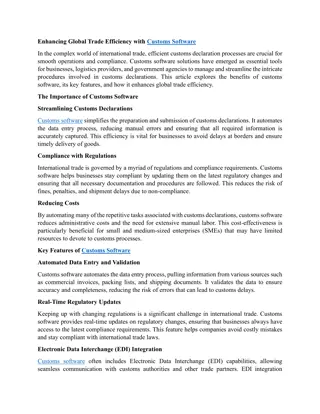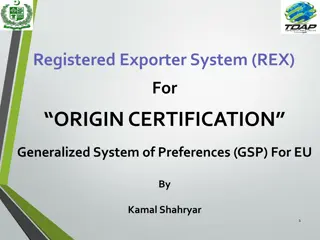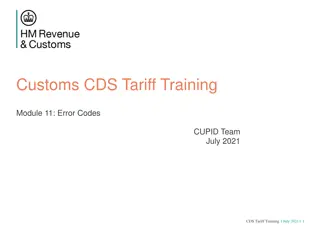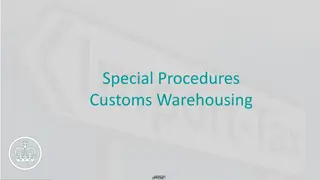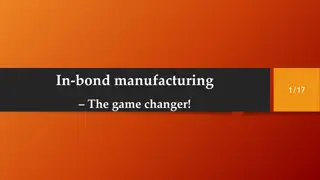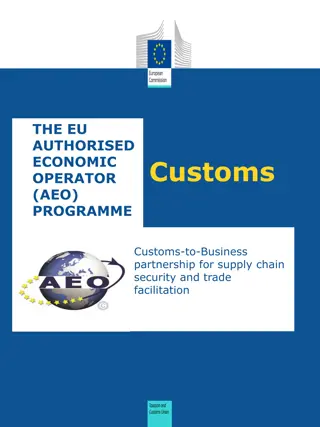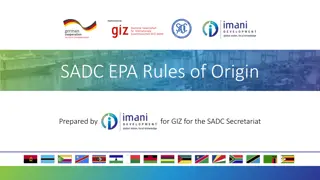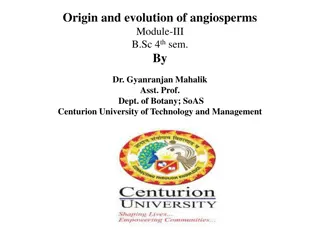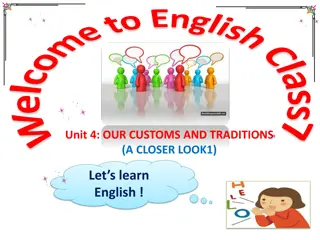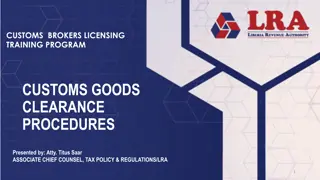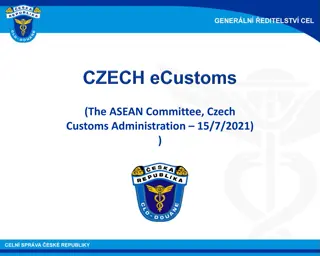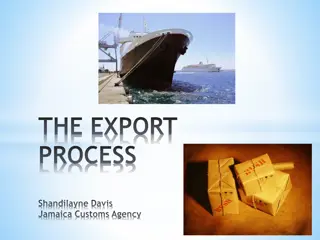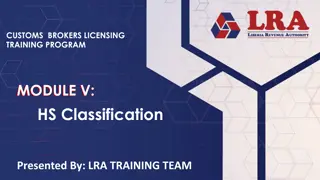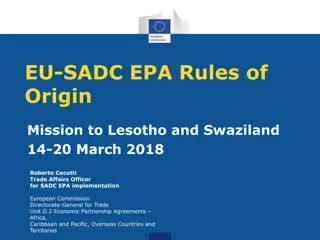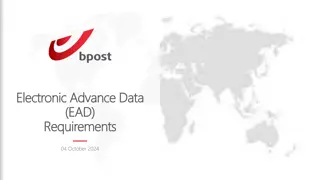Understanding Country of Origin Determination by U.S. Customs
The country of origin for exports is a crucial aspect in international trade, especially for goods exported to the U.S. This article delves into how U.S. Customs determines the actual country of origin, the implications of origin fraud, and the warning against illegitimate practices. It sheds light on the complexity of global trade operations, emphasizing the need for transparency and adherence to regulations to avoid penalties.
Download Presentation

Please find below an Image/Link to download the presentation.
The content on the website is provided AS IS for your information and personal use only. It may not be sold, licensed, or shared on other websites without obtaining consent from the author. Download presentation by click this link. If you encounter any issues during the download, it is possible that the publisher has removed the file from their server.
E N D
Presentation Transcript
Made In Vietnam Is it Really? CTRMS VIETNAM 3/F Pasteur Tower, 139 Pasteur Street District 3, Ho Chi Minh City, Vietnam (O) (+84) 977722979 (E) info@ctrms.com | (W) www.ctrms.com SOLUTIONS FOR GROWING GLOBAL BUSINESSES CTRMS Vietnam 1 Developing global trade operations in emerging markets
Exports to the U.S. involving more Exports to the U.S. involving more than one country. than one country. It is common to have more than one country of origin involved with goods exported to the U.S., primarily with manufactured or assembled goods. Sophisticated manufactured or assembled goods often have components or materials from a number of countries that are brought together to make a product that is exported. Typically, only agricultural commodities exported in large volumes are 100% the origin of a single country. 2 CTRMS Vietnam
Country of Origin Country of Origin Who Decides? Who Decides? In the U.S., it is U.S. Customs and Border Protection (CBP) that decides on the actual country of origin of imports, regardless of what the trade documents claim or say. U.S. importers are required to exercise reasonable care with their imports and face penalties if they are found not to have done so. In the U.S. China trade conflict, cases involving origin fraud or errors are anticipated with exports from 3rd countries such as Vietnam. 3 CTRMS Vietnam
Currently on the U.S. Customs Website Currently on the U.S. Customs Website Did You Receive an Email Offering a "Solution" to Avoid Antidumping Duties? Sample text of scam email: Dear purchasing manager, We have been exporting for many years from China, especially USA and Canada. If you need this product, please tell me, so I can quote you. Please do not worry about the dumping duties. This order will be operated through the intermediary trade. We will send the goods to a third country; the forwarder will repack our goods for export with other company title from that third country. It is a legit business. Contact Us, Sales Representative 4 CTRMS Vietnam
Country of Origin Country of Origin Who Decides? Who Decides? The alert on the U.S. Customs website is to warn exporters and importers that the example given is not a legitimate businessas falsely claimed in the e-mail. Title to the goods has nothing to do with Country of Origin (CO) determination. Instead, U.S. Customs will scrutinize the import by obtaining detailed information concerning the processing or manufacturing involved in the second country with the imported goods and make their own determination. 5 CTRMS Vietnam
A U.S. Customs Ruling - Origin N293792 February 16, 2018 CLA-2-44:OT:RR:NC:1:130 CATEGORY: Country of Origin Tumac Lumber Co., Inc. 805 SW Broadway Suite 1500 Portland, OR 97205 RE: The country of origin of veneered fiberboard panels from Vietnam Dear Ms. __________: In your letter, dated January 25, 2018, you requested a binding country of origin ruling. The ruling was requested on veneered fiberboard panels. Product information was submitted for our review. 6 CTRMS Vietnam
You describe a scenario wherein logs harvested in the United States are shipped to China, where they are peeled into veneers. A medium density fiberboard (MDF) sheet is manufactured in China, Vietnam, or another country. The MDF will form the panel core. In Vietnam, the veneers, which form the front and back plies, are laminated to the MDF core to form a three-layer panel. The panel is sanded, graded, and may be cut to size in Vietnam. These panels are then exported to the United States. Section 134.1(b) of the Customs Regulations (19 CFR 134.1(b)) provides that the "[c]ountry of origin" means the country of manufacture, production or growth of any article of foreign origin entering the United States. Further work or material added to an article in another country must effect a substantial transformation in order to render such other country the "country of origin" within the meaning of Part 134, Customs Regulations (19 CFR Part 134). Substantial transformation requires that "[t]here must be a transformation; a new and different article must emerge, having distinctive name, character, or use. " Anheuser-Busch Brewing Association v. United States, 207 U.S. 556, 28 S. Ct 204 (1908). 7 CTRMS Vietnam
In the instant case, the lamination of wood veneers to an MDF core effects a substantial transformation. The U.S. logs, classified in heading 4403, Harmonized Tariff Schedule of the United States (HTSUS), are cut into veneers in China, which are classifiable in heading 4408, HTSUS. This is a clear example of substantial transformation, where a new and different article is created through manufacturing. This change of heading indicates the substantial transformation, rendering China the country of origin of the veneers. The MDF core, regardless of where it is manufactured, is classifiable in heading 4411, HTSUS. The lamination of the veneers to the MDF core in Vietnam creates a new and different article: a veneered panel. Veneered panels are specifically provided for in heading 4412, HTSUS. The change from headings 4408 and 4411, HTSUS, to heading 4412, HTSUS clearly indicates a substantial transformation. We note that you identify the panel as plywood . The Explanatory Notes to the Harmonized System (ENs) for Heading 4412, HTSUS, explain that plywood is constructed of three or more layers of wood laminated together and generally disposed with the grain of each layer at an angle to that of the subsequent layer. Because the MDF core has no grain, the panel does not meet the definition of plywood . Instead, in tariff terms, it is a veneered panel , i.e., a panel consisting of a veneer affixed to a base, usually of inferior wood. 8 CTRMS Vietnam
Because the manufacturing in Vietnam creates a new and different article, substantially transformed from its veneer and MDF components, the country of origin of the panels is Vietnam. This ruling is being issued under the provisions of Part 177 of the Customs Regulations (19 C.F.R. 177). A copy of the ruling or the control number indicated above should be provided with the entry documents filed at the time this merchandise is imported. If you have any questions regarding the ruling, contact National Import Specialist Laurel Duvall at laurel.duvall@cbp.dhs.gov. Sincerely, Steven A. Mack Director National Commodity Specialist Division 9 CTRMS Vietnam
Plywood Veneer fiberboard panel CTRMS Vietnam 10
Substantial Transformation In C.S.D. 85-25, (HQ 071827), (September 25, 1984), Customs held that an assembly will not constitute a substantial transformation unless the operation is "complex and meaningful." Customs criteria for whether an operation is "complex and meaningful" depends on the nature of the operation, including the number of components assembled, number of different operations involved, and whether a significant period of time, skill, detail and quality control are necessary for the assembly operation. This criteria for determining whether a substantial transformation occurs is applied on a case-by-case basis. In C.S.D. 80-111, HQ 710564, (September 24, 1980), Customs considered whether the domestic manufacturing processes through which imported ceiling fan components become finished fans constituted a substantial transformation. In this ruling, it was stated that mere assembly of parts will not constitute a substantial transformation. We concluded that the assembly of the fan was not a substantial transformation because the processes were basically assembly line procedures which did not physically alter the components. Furthermore, we noted that the manufacturing processes were mere combining processes that were not complex or did not require a great deal of skill. 11 CTRMS Vietnam
Factors in Substantial Transformation to Factors in Substantial Transformation to Change Origin Change Origin U.S. Customs criteria for whether an operation is "complex and meaningful" depends on the nature of the operation, including: The number of components assembled, The number of different operations involved, and Whether a significant period of time, skill, detail and quality control are necessary for the assembly operation. These criteria for determining whether a substantial transformation occurs are applied on a case-by-case basis. There are 4,000 published U.S. Customs rulings on substantial transformation. 12 CTRMS Vietnam
What should an exporter in Vietnam do? What should an exporter in Vietnam do? When considering manufacture of goods in Vietnam for export to the U.S. involving China or other country inputs, consult with a qualified expert to understand whether Vietnam origin will be accepted by U.S. Customs. Study Vietnam National Decree No. 31/2018/ND-CP of March 8, 2018. It provides the rules for Vietnam Certificates of Origin. Obtain an official U.S. Customs advance ruling before manufacturing and exporting the goods to the U.S. concerning origin and country of origin marking. It s too late once the transactions are in progress. CTRMS (Vietnam) is able and pleased to work with you concerning obtaining an advance U.S. Customs ruling and Vietnam Certificates of Origin. 13 CTRMS Vietnam
AEOs in Vietnam AEO s in Vietnam AEO s or customs privileged enterprises in Vietnam enjoy a number of benefits with their import and export customs procedures, listed in MOF Circular 72/2015/TT-BTC. They enjoy exemptions from document and physical inspections. They enjoy priority when carry out customs procedures. They are allowed to self-certify compliance with specialized inspection and retain needed documents. They are allowed to withdraw goods needed for production before customs declaration and other privileges.
AEOs in Vietnam AEO s in Vietnam However, the conditions to apply for Authorized Operator ( customs privileged company ) status are very difficult to achieve. Companies must earn at least USD 100 million in annual turnover from import, export. Exporting enterprises must earn at least USD 40 million in annual turnover from export of goods manufactured in Vietnam, or Exporting enterprises must earn at least USD 30 million in annual turnover from export of goods being agriculture and aquatic products manufactured or grown in Vietnam. For customs brokers, the annual number of customs broker s declarations filed with customs procedures is at least 20,000 declarations.
AEOs in Vietnam AEO s in Vietnam The monetary targets customs privileged companies must achieve in Vietnam s AEO program keep the number of such companies very low. In Vietnam, there are less than 100 companies with this status. In 2017, 11,325 certified companies, including 4,246 US importers were members of the U.S. CTPAT (AEO) program These companies accounted for over 54 percent, by value, of what is imported into the United States, according to U.S. Customs. Vietnam s customs privileged companies monetary requirement conditions are not consistent with the WTO Trade Facilitation Agreement and must be changed as a result. This is because they discriminate between economic operators and against SME s.
AEOs in Vietnam AEO s in Vietnam The WTO s Trade Facilitation Agreement provides: Article 7.2 (b) provides that criteria for AEO programs shall not: (i) be designed or applied so as to afford or create arbitrary or unjustifiable discrimination between operators where the same conditions prevail; and (ii) to the extent possible, restrict the participation of small and medium-sized enterprises. As a result, a new approach is needed in Vietnam to make suitable changes to criterion for applying for customs privileged company status.
AEOs in Vietnam AEO s in Vietnam Modernization of Vietnam s customs privileged company status should be based only on transparent compliance by importers and exporters, as well as, security conditions that will allow for Mutual Recognition of Vietnam s program by other countries. This can be achieved through new IT systems and procedures implemented by Vietnam Customs in partnership with importers and exporters, subject to compliance audits. CTRMS (Vietnam) Co. Ltd. is pleased to work with business associations, companies and GDVC to develop a modernized AEO program for Vietnam.




